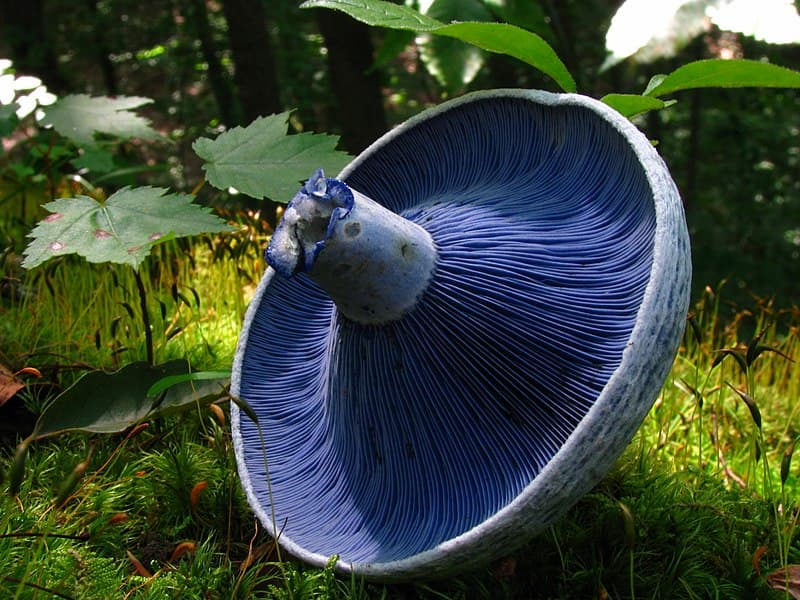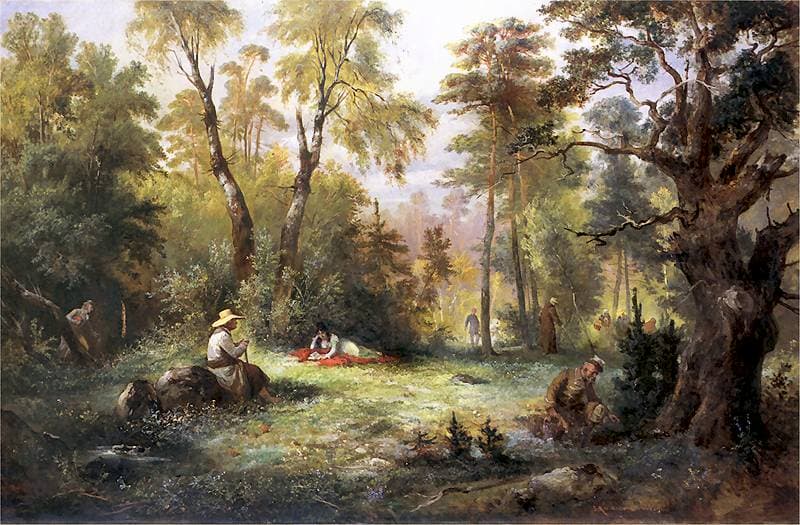Did you know that there are over 50,000 species of mushrooms? Some are hallucinogenic, a small percentage poisonous, and a few are used for their medical properties. Although the majority of mushrooms are edible, very few varieties are actually flavorful. But the roughly 20 flavorful varieties, including the truffle, morel, enoki, shitakes, chanterelle, and others, are truly delicious. They provide a range of antioxidants and other nutrients that are said to contribute to heart health and protect the body from cancer. Essentially, mushrooms are edible fungi, belonging to a kingdom of their own. They are separate from plants and animals, as they differ in their way of obtaining their nutrients. They don’t make their food from the sun’s energy or digest food internally. Instead, fungal threads grow into or around a food source, secreting enzymes that digest the food externally, which are then absolved.

The “indigo Lactarius”
A good many mushrooms are cultivated today, however, mushroom hunting in woods or forests for culinary purposes is a very popular pastime for mushroom lovers, chefs in high-end restaurants, and fans of the great outdoors. In fact, in 2014 the “National Mushroom Hunting Day” was established, and it falls on 17 May.
Dai Fujikura: Poison Mushroom (Claire Chase, flute; Dai Fujikura, electronics)

Dai Fujikura
Mushrooms became the extra-musical inspiration for Lepo Sumera (1950-2000), one of Estonia’s most talented and versatile composers. His works include two ballets, six symphonies, a piano concerto, and the famous “Mushroom Cantata.” The text of the work was written by Henn-Kaarel Hellat, and is entirely made up of Latin names for mushrooms. It is dedicated “to those who love mushrooms” and the composer explains. “I came into closer contact with mushrooms and their inner life in 1977. It was then that I discovered with amazement the fact that you hardly ever understand a text that is sung without looking into the programme, but it is possible to pick up from whatever language some casual words with a suggestive sound, a sound that gives the words a deeper meaning. Why not Latin? And if Latin, then why not the names of mushrooms? Out of patriotism, we used in the cantata the names of mushrooms that grow in Estonia.” The “Mushroom Cantata” unfolds in four movements, with each movement dedicated to specific kinds of mushrooms. “Carmen veris” (Spring Song) for spring varieties, “Timor” (Fear) for poisonous kinds, “Carmen autumnus” (Autumn Song) for autumn mushrooms and, lastly, “Luxuria” for the most delicious sorts.
Lepo Sumera: Mushroom Cantata (Janika Lentsius, flute; Kadri-Ann Sumera, piano; Madis Metsamart, percussion; Mikk Uleoja, choirmaster; Estonian Philharmonic Chamber Choir)

Franciszek Kostrzewski: Mushroom picking; illustration to III tome “Pan Tadeusz”
The jazz opera Mirror Butterfly is “a tribute to the resistance of migrants to the destruction of ecologies, economies, and cultures unleashed by slavery, conquest, and colonization.” The plot of Mirror Butterfly is inspired by “The Story of the Sword,” a Maya parable. A sword, representing conquest cuts down a tree representing Maya society. The tree transforms into a rock, which is underground, and still the sword hacks at it and shatters it. Finally, the stone transforms into water, which the sword is unable to resist. The sword rusts and withers away in this eternal elemental. The water symbolizes the flourishing grassroots organizations of indigenous communities and their allies in contemporary Mexico. In the “Mushroom Overture,” energies and minerals combine to form mushrooms and a sword. “The sword annihilates nature, fertility, and homesteads. Fallen trees are cut into slave boats and sold to faraway lands, weighed down with tears in stormy oceans. From the wreckage, mushrooms continue to grow, bringing nutrients and warning the trees of deforestation. This is the song of their resistance.”
Ben Barson: Mirror Butterfly: The Migrant Liberation Movement Suite – Scene 1: Overture of the Mushroom (Afro Yaqui Music Collective; Federico Garcia de Castro, cond.)

Jean de Brunhoff: Histoire de Babar
A poisonous mushroom decidedly changed the life of Babar the Elephant. Babar is the character in the French children’s book Histoire de Babar by Jean de Brunhoff, first published in 1931. The story focuses on Babar, whose mother is killed by hunters. As Babar flees the jungle for a big city, he meets a dear old lady who hires him as a tutor and buys him clothes and a splendid car. In the meantime, his cousins Arthur and Celeste are searching for him in the big city and urge him to return home. As the old King of the Elephants has died from eating poisonous mushrooms, the elephant council is eager for Babar to become the new King. Babar is crowned King of the Elephants and marries Celeste, with the couple dreaming under a starry sky of their future happiness. Some writers have argued that the story is superficially delightful, but can be read as a justification for colonialism. That notion was certainly not on Francis Poulenc’s mind when he set the story to music. In fact, he was improvising at the piano when the daughter of one of his visitors complained that his playing was boring. She demanded that he play her book, and placed Histoire de Babar in front of him. Apparently, “Poulenc proceeded to provide musical illustrations for the story, taking note of whatever seemed to please his audience. He only returned to the work in earnest, at the prompting of the same young relative, in 1945. And the composer Jean Françaix subsequently supplied the orchestration. If you intend to celebrate National Mushroom Hunting Day by foraging for mushrooms, please make sure you don’t pick the poisonous ones.
For more of the best in classical music, sign up to our E-Newsletter
Francis Poulenc: The Story of Babar (Barry Humphries, narrator; Melbourne Symphony Orchestra; John Lanchbery, cond.)
